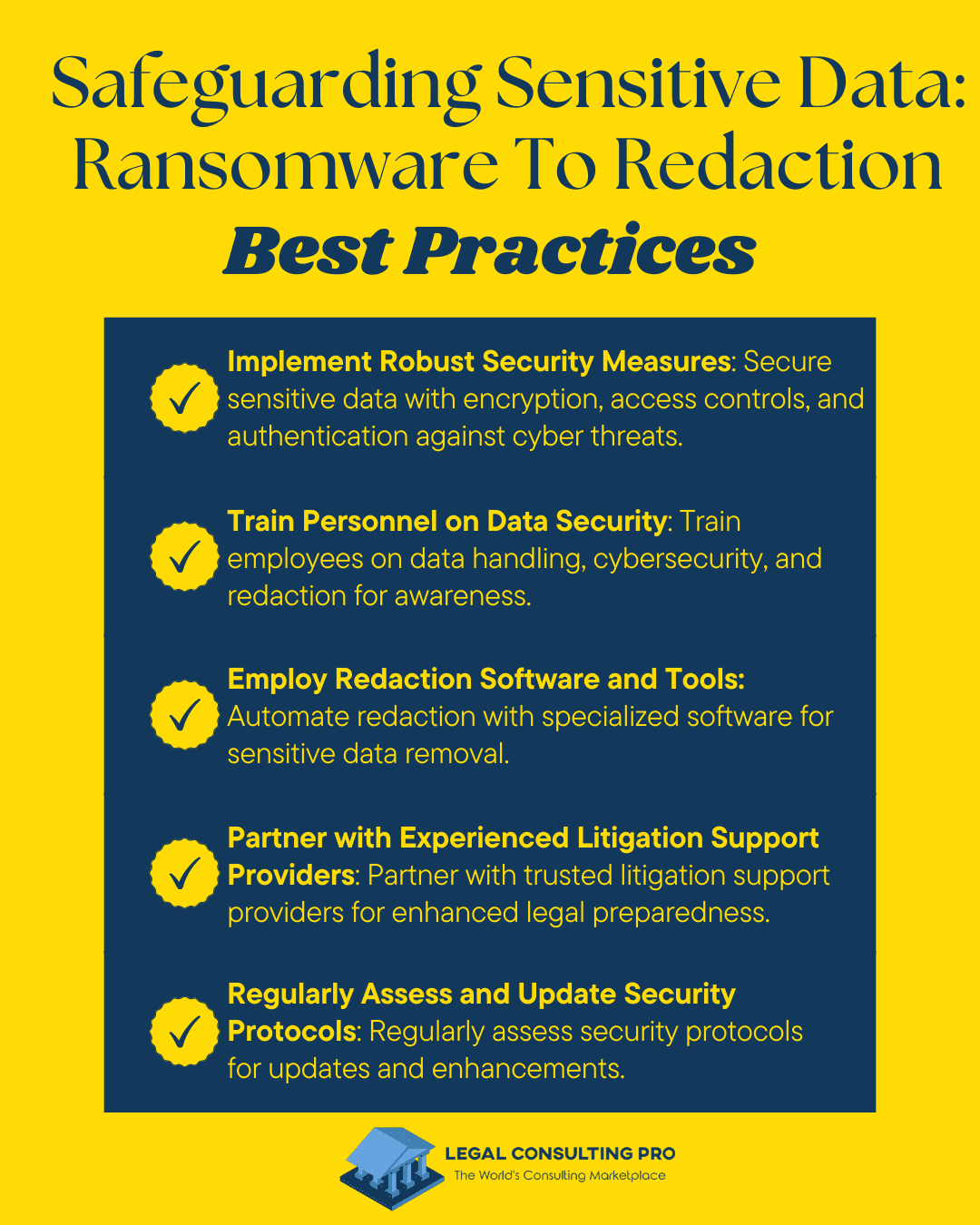In an era marked by relentless cyberattacks and data breaches, safeguarding sensitive information has become paramount for individuals and organizations alike. From ransomware assaults targeting critical infrastructure to inadvertent leaks exposing confidential data, the risks posed by cyber threats are multifaceted and ever-evolving. Amid this landscape, effective strategies for protecting sensitive data have emerged as a pressing necessity. One such approach involves the implementation of redaction techniques, coupled with litigation support services, to mitigate the risks associated with data exposure and enhance cybersecurity measures.
Understanding the Threat Landscape
Cyberattacks have become increasingly sophisticated, exploiting vulnerabilities in digital infrastructure to gain unauthorized access to sensitive data. Ransomware attacks, in particular, have emerged as a prevalent threat, with cybercriminals encrypting valuable data and demanding ransom payments for its release. These attacks can have devastating consequences, disrupting operations, compromising privacy, and inflicting significant financial losses on targeted entities.
Furthermore, inadvertent data disclosures pose a significant risk, with human error and inadequate security protocols often contributing to data breaches. Whether through email mishaps, improper data handling practices, or insider threats, the inadvertent exposure of sensitive information can have far-reaching implications for individuals and organizations, including legal and reputational ramifications.
Types of Ransomware Cyberattacks
Ransomware cyberattacks represent a significant threat to individuals and organizations, leveraging malicious software to encrypt data and demand ransom payments for its release. Understanding the various types of ransomware is essential for implementing effective cybersecurity measures and protecting sensitive information. Here are some common types of ransomware cyberattacks:
- Encrypting Ransomware: This type of ransomware encrypts files and data on the victim’s device or network, rendering them inaccessible until a ransom is paid. Examples include WannaCry, CryptoLocker, and Locky.
- Locker Ransomware: Unlike encrypting ransomware, locker ransomware does not encrypt files but instead locks the victim out of their device or system, preventing access to files, applications, or the entire system until the ransom is paid. Examples include WinLocker and Police Locker.
- Scareware or Fake Antivirus Ransomware: Scareware presents itself as legitimate security software or antivirus programs, tricking users into believing their system is infected with malware. Victims are then prompted to pay for fake antivirus software or services to remove the supposed threats.
- Mobile Ransomware: This type of ransomware targets mobile devices, such as smartphones and tablets, exploiting vulnerabilities in mobile operating systems or apps to encrypt files or lock the device. Examples include Android/Simplocker and DoubleLocker.
- Doxware or Leakware: Also known as extortionware, doxware threatens to publish sensitive or confidential data stolen from the victim’s device or network unless a ransom is paid. This tactic adds a layer of pressure on victims to comply with the attacker’s demands.
Understanding these different types of ransomware cyberattacks is critical for implementing proactive cybersecurity measures and developing effective incident response plans. By staying informed about the evolving threat landscape, organizations can better protect themselves against ransomware attacks and mitigate the risk of data breaches and financial losses.
The Role of Redaction in Data Protection
Redaction, the process of selectively removing or obscuring sensitive information from documents or digital files, serves as a crucial tool in safeguarding confidential data. By redacting sensitive content such as personal identifiers, financial details, or privileged information, organizations can mitigate the risk of data exposure and unauthorized access. Redaction techniques may involve the use of specialized software or manual processes to ensure the thorough and accurate removal of sensitive information while preserving the integrity of the underlying documents.
In the context of cybersecurity, redaction plays a vital role in data anonymization, rendering sensitive data unreadable to unauthorized users even in the event of a breach. By implementing redaction protocols as part of their cybersecurity strategy, organizations can enhance data protection measures and minimize the potential impact of cyber threats.
Integration of Litigation Support Services
In addition to redaction, the integration of litigation support services further strengthens organizations’ ability to protect sensitive data and mitigate legal risks. Litigation support services encompass a range of specialized solutions aimed at assisting legal professionals in managing electronic data and supporting litigation proceedings. These services may include data collection, electronic discovery (eDiscovery), data analysis, and document review, among others.
By leveraging litigation support services, organizations can effectively navigate complex legal challenges while ensuring compliance with regulatory requirements and preserving the confidentiality of sensitive information. Litigation support services professionals possess expertise in handling vast amounts of electronic data, identifying relevant information, and preparing evidence for legal proceedings. Moreover, their involvement can streamline the discovery process, expedite case preparation, and enhance overall litigation efficiency.
Practical Applications and Best Practices
In practice, the effective protection of sensitive data requires a comprehensive and proactive approach that encompasses both technical solutions and robust operational practices. Organizations should prioritize the following best practices to safeguard sensitive information in the age of cyberattacks:
- Implement Robust Security Measures: Deploy encryption, access controls, and authentication mechanisms to safeguard sensitive data against unauthorized access and cyber threats.
- Train Personnel on Data Security: Provide comprehensive training and awareness programs to educate employees on data handling best practices, cybersecurity threats, and redaction techniques.
- Employ Redaction Software and Tools: Utilize specialized redaction software and tools to automate the redaction process and ensure the thorough removal of sensitive information from documents and digital files.
- Partner with Experienced Litigation Support Services Providers: Collaborate with reputable litigation support services providers to access expertise in data management, eDiscovery, and document review, enhancing legal preparedness and compliance.
- Regularly Assess and Update Security Protocols: Conduct regular assessments of security protocols, policies, and procedures to identify vulnerabilities and implement necessary updates or enhancements.

Conclusion
In an increasingly digital and interconnected world, protecting sensitive data against cyber threats has become an imperative for individuals, businesses, and government entities alike. From ransomware attacks to inadvertent data disclosures, the risks posed by cyber threats are diverse and pervasive. Redaction techniques, coupled with litigation support services, offer effective strategies for mitigating these risks and enhancing cybersecurity measures. By implementing robust security measures, training personnel on data security best practices, and leveraging specialized tools and expertise, organizations can fortify their defenses and safeguard sensitive information in the age of cyberattacks. Through proactive efforts and strategic investments in data protection, stakeholders can mitigate legal and reputational risks while maintaining trust and confidence in their digital operations.
Similar Blog:
Litigation Support: IT-Legal Nexus for a Better Data Security













































